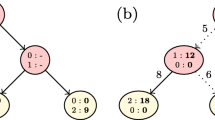Abstract
Flow goods (like electricity) are sold through auctions in a dynamic framework. An important design question is the frequency of such auctions. We use a simple dynamic auction model in continuous time to answer this question. We focus on the relationship between the persistency of bidders’ valuations and the optimal choice of frequency. If the seller focuses on the equilibrium in which bidders follow a repeated static Nash strategy, then the frequency of auctions should typically increase when persistency declines. However, accounting for the fact that bidders can follow different equilibria that are collusive in nature, the comparative statics are reversed, forcing the seller to reduce the frequency when bidders’ valuations are less persistent. The argument builds on the fact that high frequency auctions are more conducive to collusion among bidders.
Similar content being viewed by others
Notes
A notable exception is a recent important paper by Athey and Bagwell (2008), who obtain a numerical solution for a model with persistence in types.
We are not adopting a general mechanism design approach here as we wish to maintain the format of flow-auction environments such as in the electricity industry.
This condition implies that the number of bidders is at least three, as we assumed earlier.
References
Abreu D, Pearce D, Stachetti E (1990) Toward a theory of discounted repeated games with imperfect monitoring. Econometrica 58:1041–1063
Athey S, Bagwell K (2008) Collusion with persistent cost shocks. Econometrica 76(3):459–677
Ausubel LM, Cramton P (1998) Auctioning securities, working paper. University of Maryland, Maryland
Cramton P, Stoft S (2007) Why we need to stick with uniform-price auctions in electricity markets. Electr J 20(1):26–37
Congressional Budget Office paper (2001) http://www.cbo.gov/showdoc.cfm?index=3062&sequence=0. Accessed 1 Apr 2016
McAfee RP, McMillan J (1992) Bidding rings. Am Econ Rev 82(3):579–599
Skrzypacz A, Hopenhayn H (2004) Tacit collusion in repeated auctions. J Econ Theory 114(1):153–169
Author information
Authors and Affiliations
Corresponding author
Appendix
Appendix
Proof of Lemma 1
We need to prove that
\(\Pi (k,a)\!=\!\sum _{i=0}^\infty e^{-irk}\int _0^k \big ( x_{n-1} e^{-at}+\bar{{x}}(1-e^{-at}) \big )e^{-rt}dt \) decreases with k.
By taking the integral we get
and by taking the sum this expression can be rewritten as \(\Pi (k,a)=\frac{x_{n-1} -\bar{{x}}}{a+r}\cdot \frac{e^{rk}-e^{-ak}}{e^{rk}-1}+\frac{\bar{{x}}}{r}\); in order to study this expression as a function of k we should concentrate on the following (here we use the assumption that \(x_{n-1} -\bar{{x}}>0)\): \(\frac{d}{dk}\frac{e^{rk}-e^{-ak}}{e^{rk}-1}=\frac{e^{-ak}\left( {-a+e^{rk}(a+r-re^{ak})} \right) }{\left( {e^{rk}-1} \right) ^{2}}\). The sign of this expression is determined by \(-a+e^{rk}(a+r-re^{ak})\). This expression can be also written as \(-a+e^{rk}(a+r-re^{ak})=(a+r)(e^{rk}-1)+r(1-e^{(r+a)k})\). By replacing the exponents with their Taylor series we obtain
\(\square \)
Proof of Lemma 2
Consider first the special case in which the price is constant; that is, the two highest types bid some price \(p\ge 0\). In this case we will argue that condition (1) is not only necessary but also sufficient. Consider what the incentives of the second-highest type from deviating are. According to the collusive scheme his payoff from a single auction in the future, conditional on receiving it (i.e., having the highest value \(\hbox {x}_\mathrm{n})\) is
in each interval in which he has the highest type at the beginning of this interval and zero otherwise. His payoff in a static Nash in future intervals is given by
This leads to a difference of
for all auctions starting with the second auction. To get the present value we multiply by the probability of having the highest value and discount to the present.
Hence, we conclude that the benefit from following the collusive scheme as compared to the payoff from deviation is given by
We compare this to the current profit from deviation that is given by
Hence, we conclude that (1) is both necessary and sufficient. Since this condition does not depend on p, (ii) also follows. To complete the proof for part (i) we need to show that if (1) does not hold then we cannot support a scheme with non-negative prices. So we assume by contradiction that \(\frac{1}{n}\sum _{i=1}^\infty {(1-e^{-ika})e^{-rik}} =1-\Delta \hbox { for some }\Delta \ge 0\) and that there exists a price scheme in which the price in interval i is given by \(p_i\). For this to be an equilibrium it must be that for each i we have that
Otherwise at time \(t=ik\) there is an incentive to deviate. We consider a weighted average of future prices at time \(t=ik\); let
Using this notation we can rewrite (3) as
This implies that
Note that also
where \(\alpha =\frac{(1-e^{-ka})e^{-rk}}{\sum _{j=1}^\infty {e^{-jk(a+r)}} }\). Using (4) and (5) we conclude that
Since \((\alpha \left( {1-\Delta } \right) +(1-\alpha ))<1\) we conclude that \(\lim _{i\rightarrow \infty } X(x_{n-1} ,a,k)-P_i =\infty \) which implies that \(\lim _{i\rightarrow \infty } P_i =-\infty \), and so we contradict our assumption of non-negative prices. \(\square \)
Proof of Theorem 1
Let
One can easily verify that
-
a.
f is continuous,
-
b.
\(\lim _{k\rightarrow 0} f(k,a)=\infty ,\lim _{k\rightarrow \infty } f(k,a)=0,\) and
-
c.
f is positive.
-
d.
\(\frac{\partial }{\partial a}f(k,a)>0\)
We will show that
-
e.
\(\frac{\partial }{\partial k}f(k,a)<0\)
Both parts (i) and (ii) follow from the above properties. To see that item e indeed holds note that
Define \(g(x)\equiv \frac{e^{kx}x}{(1-e^{kx})^{2}_{}}\); we will argue that for every k, g(x) is a decreasing function of x. We note that
Denote y=kx; then the parenthesis can be written as
To complete the proof we need to show that \(h(y)<0\) for all \(y>0\). To see this note that \(h(0)=0\) and that \(h'(y)=-e^{y}y-1<0\).\(\square \)
Rights and permissions
About this article
Cite this article
Kremer, I., Wiener, Z. & Winter, E. Flow auctions. Int J Game Theory 46, 655–665 (2017). https://doi.org/10.1007/s00182-016-0549-3
Accepted:
Published:
Issue Date:
DOI: https://doi.org/10.1007/s00182-016-0549-3




